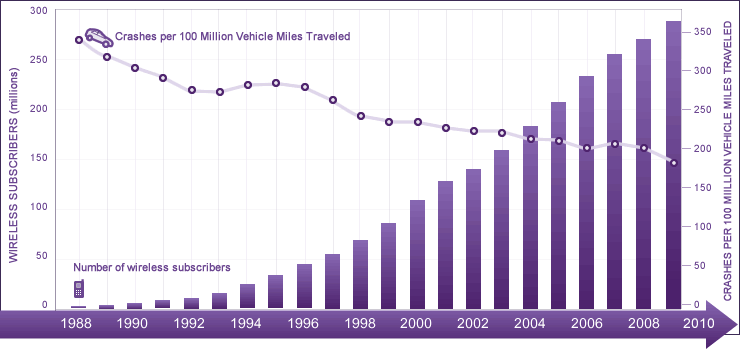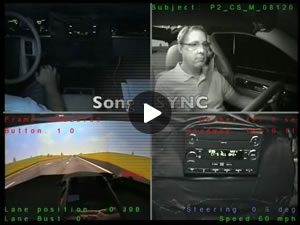Case Study: Driver Distraction
Over the past two decades, cellular phones have gone from clunky novelties to ubiquitous must-haves. Wireless subscriptions in the U.S. have grown from about 28 million in 1995 to about 280 million by 2010 – a tenfold increase. The public has become accustomed to using cell phones everywhere – at home, on the street, in restaurants, at the office, while shopping and – of most interest to Ford’s safety researchers – while driving.
The ubiquity of cell phones – coupled with the proliferation of portable music players in vehicles – has heightened concerns about driver distraction. We at Ford agree that this is an important safety issue and we have taken steps to address it. We also believe that continued research is needed to better understand the complex interactions involved in this issue, and we are actively participating in that research.
In 2009 and again in 2010, the National Safety Council (NSC) called for a total ban on the use of cell phones, both handheld and hands-free, while driving. The NSC stated that cell phone use while driving is “...a very high-risk behavior with significant impact on crashes....” And indeed, some studies have concluded that there’s no difference in driver behavior whether using handheld or hands-free phones. In many of those laboratory studies, participants in simulated driving situations were observed while being asked to engage in in-depth conversations on challenging or emotional subjects, such as the latest political scandal or a near-death experience. Such intense and lengthy discussions can indeed be distracting.
Naturalistic driving studies – in which study participants’ driving performance, “eye glance behavior,” driving environment and in-vehicle activities are observed and recorded over weeks or months in real-world situations – have revealed different results. For example, naturalistic studies completed by the University of Michigan’s Transportation Research Institute reveal that, when immersed in real traffic conditions, drivers using cell phones by and large exhibit prudent driving behavior.
In addition, the landmark 100-Car Naturalistic Driving Study conducted by the Virginia Tech Transportation Institute (VTTI) found that almost 80 percent of all crashes and 65 percent of all near-crashes involved the driver looking away from the forward roadway just prior to the onset of the incident. In 2008, the study’s authors summarized their findings in this way: “...it is a rare case that a crash occurs while the driver’s eyes are on the forward roadway, regardless of any other ‘cognitive demand’ that they might be engaged in.”
In 2009, the VTTI published a new naturalistic driving study based on commercial vehicle operator experience. This study suggested that there is a 23-fold increase in risk when commercial operators send text messages while driving, and that some behaviors like checking gauges and talking on the cell phone can have protective benefits.
Beyond the VTTI and University of Michigan studies, there exists a considerable body of published research that indicates the superiority of hands-free voice interfaces as compared to handheld or visual–manual interfaces for the same tasks of command or data entry. These studies show advantages in driver performance, eye glance behavior toward the roadway, and object and event detection when the driver can keep eyes on the road and hands on the wheel. It is also interesting to note that, despite the significant increase in cell phone use in recent years, crash rates have fallen over the same time period (specifically, in both the categories of “fatal crashes” and “police-reported crashes”). (See graph below.)
Related Links
Police Reported Crash Rates and Wireless Subscription Growth 1988–2009

Recently, the VTTI 100-Car study has been criticized because only a handful of crashes were recorded, near-miss events were analyzed as surrogates for crashes without empirical justification, and there were only 107 primary drivers (and 132 occasional drivers). In 2010, the U.S. Department of Transportation (DOT) released several important reports that address these issues. One study of commercial truck and bus drivers was based on a data set collected and coded by DriveCam®, a vendor of onboard safety monitoring systems (OBMS). This data set was obtained from 13,306 vehicles and included 1,085 crashes, as well as many times that number of near-crashes, safety-critical events and baseline events. The results, highly consistent with the 100-Car findings, were that activities that take drivers’ eyes off the road were associated with crash and near-crash involvement, but listening and talking tasks were not. A separate study conducted by VTTI on the relationship between near-misses and crashes revealed that (a) there was no evidence of different causal mechanisms between the two; (b) the near-misses underestimate risk ratios associated with crashes; but (c) the use of near-misses as surrogates for crashes greatly increases the likelihood of detecting statistically significant differences (when present) because of the much larger sample size of near-misses obtainable in naturalistic driving studies.
Another U.S. DOT-sponsored research study released in 2010 lends new insights into the case-crossover method which produced estimates of “over four-times greater risk of being in a crash” when using a cell phone. (This risk level has been cited by the IIHS, as discussed below.) Unlike the epidemiological studies, the 100-Car data set of video and engineering data has no uncertainty about exact crash times, cell phone use vs. non-use during the hazard interval leading up to the crash or near-crash, whether or not the driver was actually driving during the control day, and so forth. The researchers reported that the case-crossover odds ratios were lower, not higher, than the two-cohort odds ratios, strongly suggesting that the fourfold figure from the non-naturalistic epidemiological studies is inflated. Finally, it is noteworthy that the Strategic Highway Research Program II naturalistic driving study was launched in 2010. This study, which Ford supports with technical advice and information provided on Ford vehicle on-board information channels, will collect data for up to two years each on some 4,000 drivers.
In 2009, the IIHS evaluated insurance data to see if there were demonstrable benefits to bans on handheld cellphone use. As noted above, the IIHS had previously claimed that driving while using a cell phone causes a four-fold increase in risk, thus it was expected that insurance data would show a drop in claims after the enactment of handheld bans. However, the data showed no observable drop in claims as expected. In addition, the IIHS has published studies indicating that handheld phone bans in New York, Washington, DC, and Finland led to an initial decline in the banned behavior followed by a return to pre-ban levels of handheld phone use within roughly one year. The IIHS is now re-evaluating its position on distracted driving and cell phone use risks.
For several years now, Ford has been focused on the issue of driver distraction and has taken steps to enhance driving safety for those who use cell phones and other telematics devices while driving. Through its work with the Alliance of Automobile Manufacturers, for example, Ford helped lead the development of an industry-wide Driver Distraction Voluntary Agreement, and Ford designs its telematics systems to meet that agreement. In addition, Ford was the first automotive manufacturer to support the Schumer Bill, the first bill in Congress to propose a ban on handheld texting while driving. Ford also clarified its employee policies to explicitly ban the practice. Ford Driving Skills for Life, Ford’s driver education program, includes modules on the importance of avoiding distracted driving. In 2010 the U.S. Secretary of Transportation convened a two-day Distracted Driving Summit to open a dialogue between the various stakeholders interested in this issue. Ford took part by sending representatives to attend the Summit as well as leading the development of the Alliance of Automobile Manufacturers’ presentation for the Advanced Technologies Panel.
Ford SYNC®, our voice-activated in-car connectivity system, has been shown to enhance the ability of drivers to keep their eyes on the road and hands on the wheel while using cell phones and music players. Simulator research at Ford has shown that SYNC substantially reduces drivers’ eyes-off-road time and improves lane-keeping, speed maintenance, and object and event detection response times, when compared to handheld devices for the same tasks. (See the above video for an example. It shows how long it takes a driver to find a song on an MP3 player manually vs. using SYNC’s voice-activated system.) This study evaluated driver performance, not driver behavior in the real world. However, these performance effects are consistent with the 100-Car VTTI Study, and strongly suggest that SYNC can reduce driver distraction in situations where a hand-held device would otherwise be used. In addition, these findings were recently confirmed by independent, on-road testing performed by the VTTI and published at the SAE Congress.
Ford customers reinforce the array of compelling research discussed above, as a large majority say they believe voice-controlled systems such as SYNC provide benefits and that they take other responsible measures while using electronics. According to a new survey of Ford owners of vehicles equipped with SYNC, 88 percent use the system’s hands-free features, and 74 percent use the unique voice-control functions to use electronics while driving. A large majority of these customers also take other safety measures, such as increasing following distances while using electronics, and 77 percent say they don’t use them in hectic driving conditions.
Ford recognizes that drivers will use cell phones and music players while driving, and that evolving technologies like text messaging are growing increasingly popular. Text messaging is a particular concern, as it requires significant time looking away from the roadway to operate. Ford’s SYNC system addresses this concern as well: when a text message arrives, it does not display that message but instead reads it aloud through text-to-speech technology, and then provides a list of canned replies for the driver to select rather than key-in or compose manually. SYNC also locks out certain features (such as adding or editing a phone book contact) while driving.
We believe that further education is needed to help drivers understand the importance of focusing on the driving task and keeping their hands on the wheel and eyes on the road. Ford plans to continue to work with the government and other safety-related groups to discuss measures that can effectively reduce driver distraction and improve driving safety. We also plan to participate in continued research that can further our understanding of safe driving and help spread the message of safe driving.
- Overview
- Economy Data
- Environment Data
- Society Data

